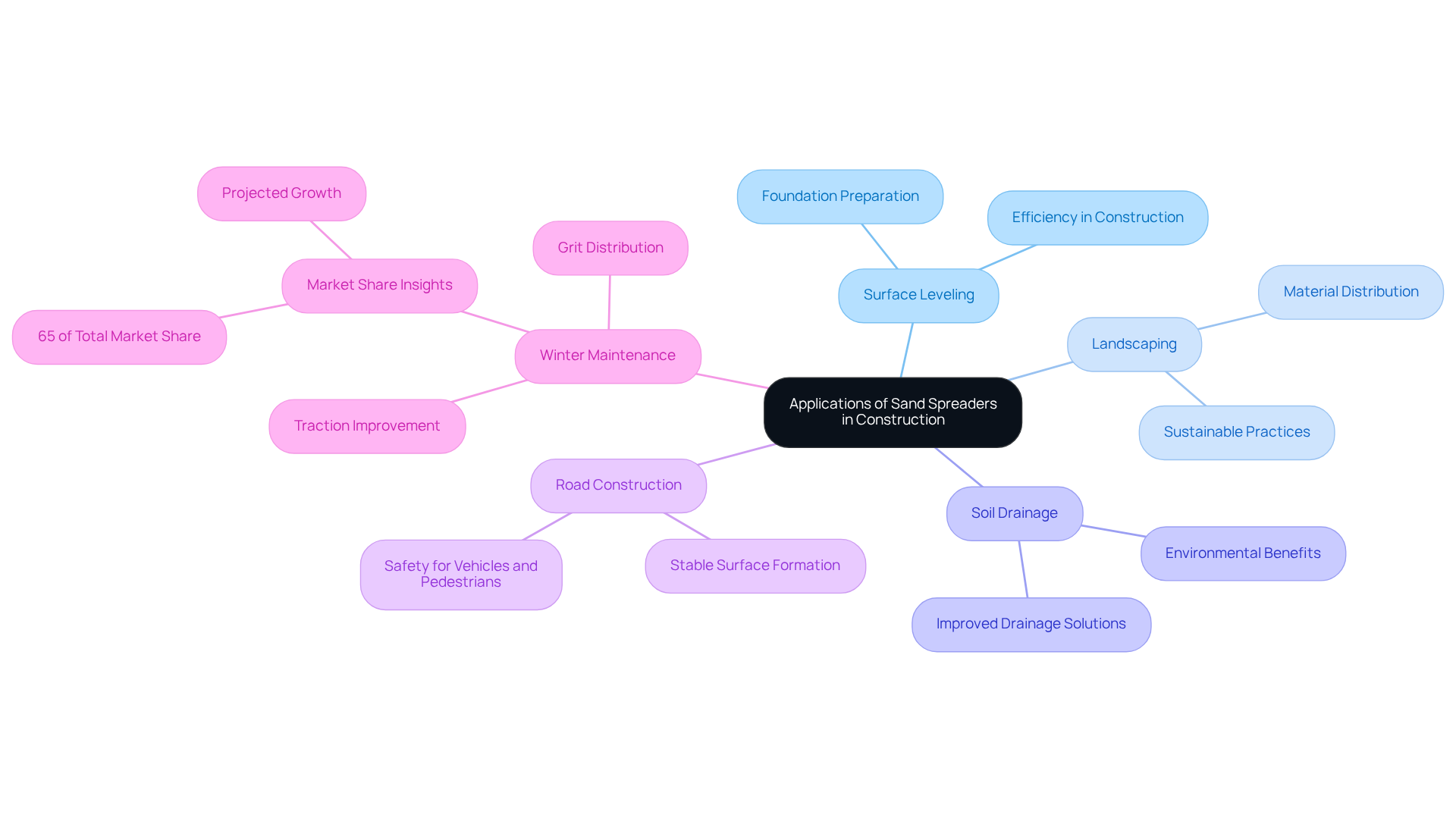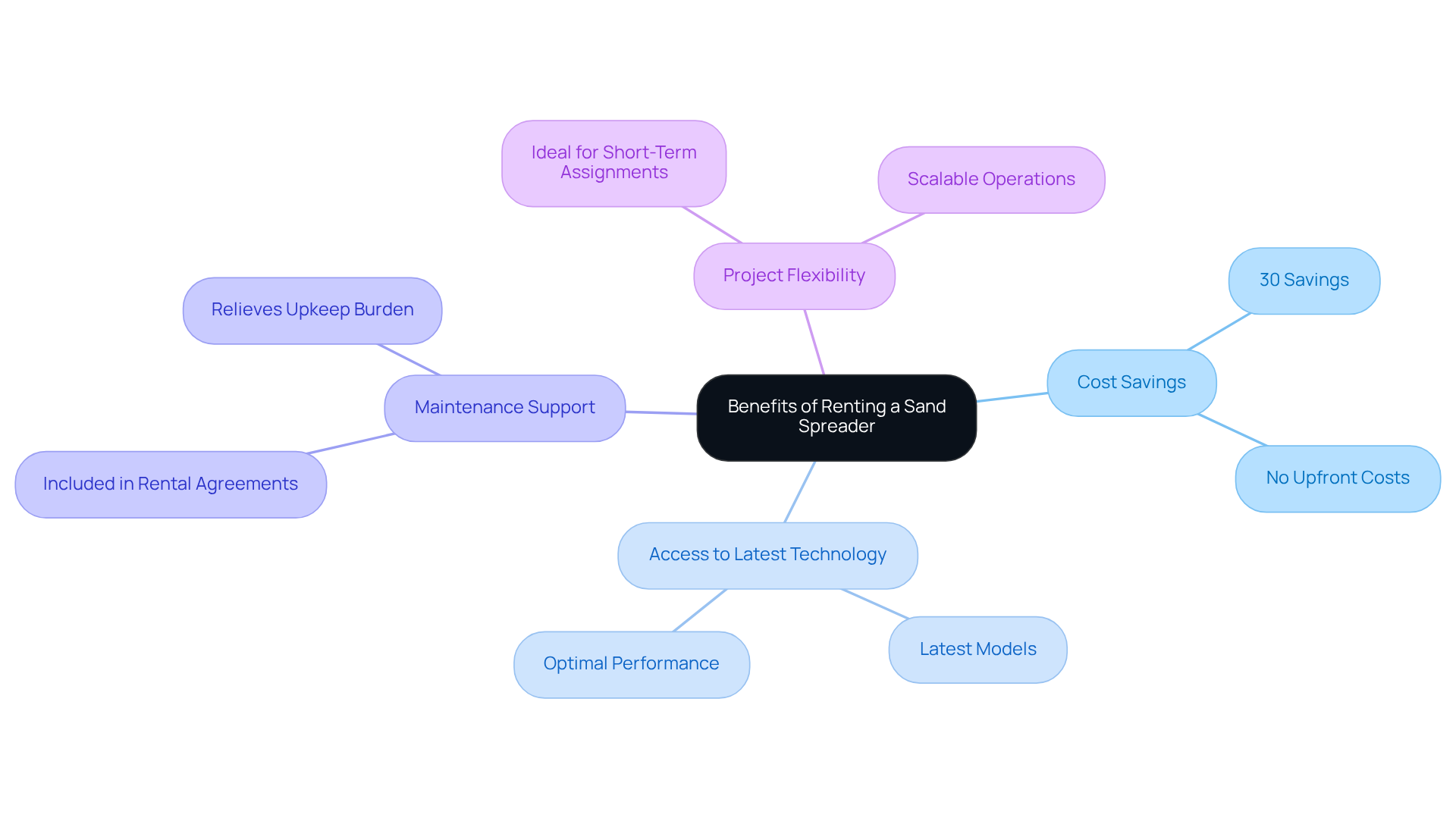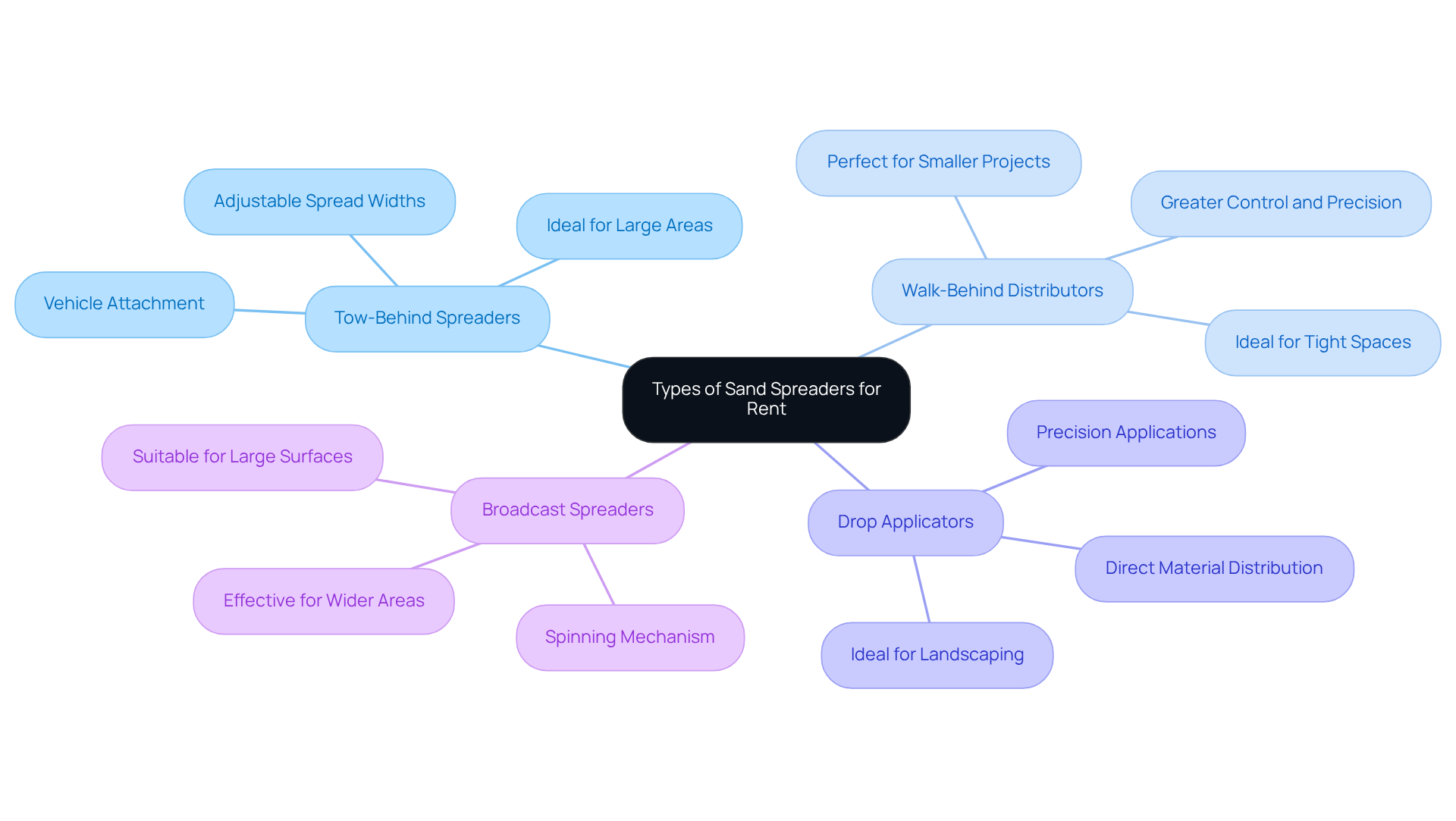Overview
This article highlights the features and benefits of renting sand spreaders, underscoring their critical role in construction and landscaping projects. Renting these machines not only minimizes upfront costs—potentially saving you up to 30% compared to purchasing—but also grants access to cutting-edge technology and maintenance support. This combination significantly enhances project efficiency and flexibility.
In addition to cost savings, renting sand spreaders allows you to utilize the latest innovations in equipment. These machines are designed to improve workflow and deliver superior results, making them a valuable asset for any project. Furthermore, the maintenance support that comes with rental agreements ensures that you can rely on the equipment without the burden of upkeep.
Moreover, many satisfied customers have shared their positive experiences with renting sand spreaders, reinforcing the reliability and quality of these machines. Testimonials highlight how these rentals have transformed their projects, providing the necessary tools to achieve outstanding results. For example, one customer reported a significant increase in productivity after switching to rented equipment.
In conclusion, renting sand spreaders presents an opportunity to enhance your project outcomes while managing costs effectively. Take action today and explore your options for equipment rental to ensure your next construction or landscaping endeavor is a success.
Key Highlights:
- Sand spreaders distribute granular materials evenly across surfaces, critical for tasks like levelling and improving drainage.
- The SaltDogg SHPE0750 model features a poly impeller, a 12V DC motor, and a maximum throwing distance of 30 feet, suitable for various applications.
- Sand spreaders can be towed or operated manually and are compatible with vehicles ranging from 1/4 tonne to 3/4 tonne.
- They are essential in construction for site preparation, landscaping, and winter maintenance, significantly enhancing project efficiency.
- Winter maintenance accounts for 65% of the market share for salt applicators, highlighting their importance in safety during icy conditions.
- The demand for soil distributors is expected to grow, driven by a focus on efficient drainage and sustainable practises, with the market projected to reach $900 million by 2024.
- Renting sand spreaders reduces upfront costs, with potential savings of up to 30% compared to purchasing, and provides access to the latest technology.
- Rental agreements often include maintenance support, offering flexibility for short-term projects.
- Types of sand spreaders available for rent include tow-behind, walk-behind, drop applicators, and broadcast spreaders, each suited for different project needs.
Introduction
A sand spreader for rent is an essential tool in the construction and landscaping industries, meticulously designed to guarantee an even distribution of materials across various surfaces. By grasping its features and functionalities, users can unlock substantial benefits, including cost savings and improved project efficiency.
However, with a multitude of models and types available, how can one ascertain the best fit for specific needs? This article explores the crucial aspects of sand spreaders, examining their applications, the advantages of renting, and the diverse options available to elevate construction projects.
Defining a Sand Spreader: Key Features and Functionality
A sand spreader for rent is an essential piece of equipment designed to provide an even distribution of granular materials across various surfaces, such as lawns, driveways, and construction sites. It features a hopper for holding sand, a robust spreading mechanism—often a spinner or drop system—and adjustable settings to control the spread rate. For example, the SaltDogg SHPE0750 model is equipped with a 12-inch poly impeller, a 12V DC motor with .50 HP, and a maximum throwing distance of 30 feet, making it an ideal choice for a variety of applications.
These sand spreaders for rent can be towed behind vehicles or operated manually, depending on the specific model, and they are compatible with utility vehicles and trucks ranging from 1/4 ton to 3/4 ton. Their functionality is crucial for tasks such as leveling surfaces, improving drainage, and enhancing traction on icy roads. Understanding these characteristics allows users to select the appropriate applicator tailored to their unique requirements.
In practical applications within the construction industry, a sand spreader for rent is often employed by material distributors for site preparation and landscaping, where even allocation of resources is critical for project success. Recent advancements in sand distribution devices, like the in-cab variable speed controller featured in the SHPE0750, significantly enhance user control and operational efficiency. This model weighs 280 lbs. and measures 28 inches in height, 48 inches in width, and 53 inches in length, making it a practical solution for various construction needs. As noted by users, including a review from Ordel S, mastering the speed settings can optimize performance, ensuring that the device meets expectations even in challenging conditions. Additionally, the device is equipped with a digital display for settings, facilitating precise adjustments. Driveway markers are also available for purchase at $2.88, complete with free tech support, adding further convenience for users. Ultimately, understanding these attributes and functionalities empowers building specialists to select the most suitable aggregate distributor for their specific needs.

Applications of Sand Spreaders in Construction Projects
Sand distributors play a crucial role in construction initiatives, fulfilling various purposes that significantly enhance efficiency and effectiveness. They are vital for:
- Leveling surfaces prior to foundation work
- Distributing materials for landscaping
- Improving soil drainage
In road construction, aggregate distributors contribute to the formation of stable surfaces, ensuring safety for both vehicles and pedestrians. Furthermore, during winter maintenance, these devices are indispensable for spreading grit on slippery roads, greatly improving traction and safety. Their capacity to cover extensive areas quickly and evenly makes them essential for both residential and commercial projects.
Notably, winter maintenance constitutes approximately 65% of the total market share for salt applicators, underscoring their importance in the industry. As we approach 2025, the demand for soil distributors in landscaping projects is projected to increase, driven by a heightened focus on efficient drainage solutions and sustainable landscaping practices. The market for salt and granular materials is estimated to reach around $900 million in 2024, with expectations of expanding at a CAGR of 5.5% until 2034. Industry experts agree that material applicators serve not only as efficient distribution tools but also as essential components for enhancing overall project outcomes.
Moreover, advancements in technology, including the integration of intelligent features and sustainable materials, are revolutionizing the landscape of material distributors, boosting their effectiveness in meeting contemporary construction demands. With the right equipment, you can ensure a successful project outcome. Engage with us today to explore how our sand spreader for rent can elevate your construction and landscaping efforts.

Benefits of Renting a Sand Spreader for Construction Needs
Leasing a material distributor presents substantial advantages for construction projects. It primarily eliminates the significant upfront costs associated with purchasing equipment, enabling businesses to allocate funds to other critical areas. In 2025, the cost savings from leasing aggregate distributors can be remarkable, particularly for projects with diverse needs. Research indicates that construction firms may save up to 30% on equipment expenses by opting for rentals instead of acquisitions. Furthermore, access to the latest models and technology through rentals ensures optimal performance and efficiency, which is vital in today's competitive environment.
Additionally, rental agreements often include maintenance and support, relieving users of the burden of upkeep. This flexibility is especially beneficial for short-term assignments or seasonal tasks, where the practicality of owning a sand spreader for rent may be uncertain. Project managers frequently highlight that renting not only reduces costs but also enhances project flexibility, making it a strategic choice in the ever-evolving construction landscape. As one construction manager aptly stated, 'Renting allows us to scale our operations quickly without the financial strain of purchasing equipment we may only need for a short time.'
In conclusion, the advantages of leasing equipment are clear. By choosing to rent, businesses can optimize their budgets, access cutting-edge technology, and enjoy the convenience of maintenance support. Take the next step in enhancing your project efficiency—consider leasing your equipment today.

Types of Sand Spreaders Available for Rent
Various kinds of material distributors, including a sand spreader for rent, are available, each tailored for specific applications. These distributors include:
- Tow-Behind Spreaders: Designed to be attached to vehicles, these spreaders are ideal for covering large areas such as fields or parking lots. They often feature adjustable spread widths and rates, ensuring flexibility for different projects.
- Walk-Behind Distributors: Perfect for smaller projects, these manual devices provide greater control and precision, especially in tight spaces where accuracy is crucial.
- Drop Applicators: These devices distribute material directly beneath the hopper, making them ideal for precise applications, such as in landscaping where accuracy is paramount.
- Broadcast Spreaders: Utilizing a spinning mechanism, these spreaders effectively distribute sand over wider areas, making them particularly suitable for larger surfaces.
Each type offers distinct advantages, and the choice of a sand spreader for rent ultimately depends on the specific needs of your project. By selecting the right distributor, you can ensure efficiency and effectiveness in your material application.

Conclusion
A sand spreader for rent is an essential asset in the construction and landscaping sectors, ensuring even material distribution while significantly enhancing project efficiency. Understanding the features and functionalities of these machines empowers users to make informed decisions, leading to substantial cost savings and improved project outcomes.
This article highlights the key characteristics of sand spreaders, showcasing their versatile applications in construction, including:
- Leveling surfaces
- Improving drainage
- Enhancing traction during winter maintenance
Furthermore, it emphasizes the benefits of renting these devices, such as:
- Reduced upfront costs
- Access to the latest technology
- Maintenance support
Collectively, these advantages contribute to greater operational flexibility.
As the demand for efficient construction solutions continues to rise, considering a sand spreader for rent emerges as a strategic choice for businesses aiming to optimize their budgets and enhance project outcomes. Engaging with rental services not only grants access to the right equipment but also empowers users to effectively tackle diverse challenges in construction and landscaping. Seize the opportunity to elevate project efficiency by exploring rental options for sand spreaders today.
Frequently Asked Questions
What is a sand spreader and what is its primary function?
A sand spreader is a piece of equipment designed to provide an even distribution of granular materials, such as sand, across various surfaces like lawns, driveways, and construction sites.
What are the key features of a sand spreader?
Key features include a hopper for holding sand, a robust spreading mechanism (often a spinner or drop system), and adjustable settings to control the spread rate.
Can you provide an example of a sand spreader model and its specifications?
The SaltDogg SHPE0750 model features a 12-inch poly impeller, a 12V DC motor with .50 HP, and a maximum throwing distance of 30 feet.
How can sand spreaders be operated?
Sand spreaders can be towed behind vehicles or operated manually, depending on the specific model.
What types of vehicles are compatible with sand spreaders?
Sand spreaders are compatible with utility vehicles and trucks ranging from 1/4 ton to 3/4 ton.
What are some practical applications of sand spreaders in the construction industry?
Sand spreaders are often used by material distributors for site preparation and landscaping, where even allocation of resources is critical for project success.
What advancements have been made in sand spreader technology?
Recent advancements include features like in-cab variable speed controllers that enhance user control and operational efficiency.
What are the dimensions and weight of the SaltDogg SHPE0750 model?
The SaltDogg SHPE0750 weighs 280 lbs and measures 28 inches in height, 48 inches in width, and 53 inches in length.
How can users optimize the performance of a sand spreader?
Users can optimize performance by mastering the speed settings, which can ensure the device meets expectations even in challenging conditions.
Does the sand spreader have any additional features for user convenience?
Yes, it is equipped with a digital display for settings, facilitating precise adjustments, and driveway markers are available for purchase, complete with free tech support.




